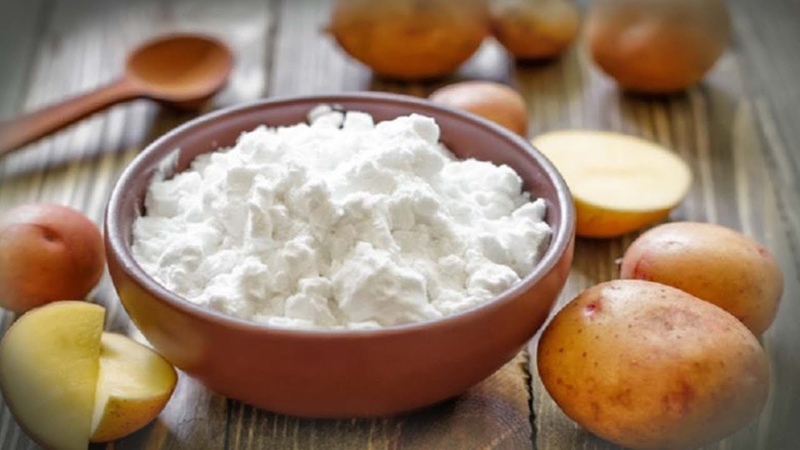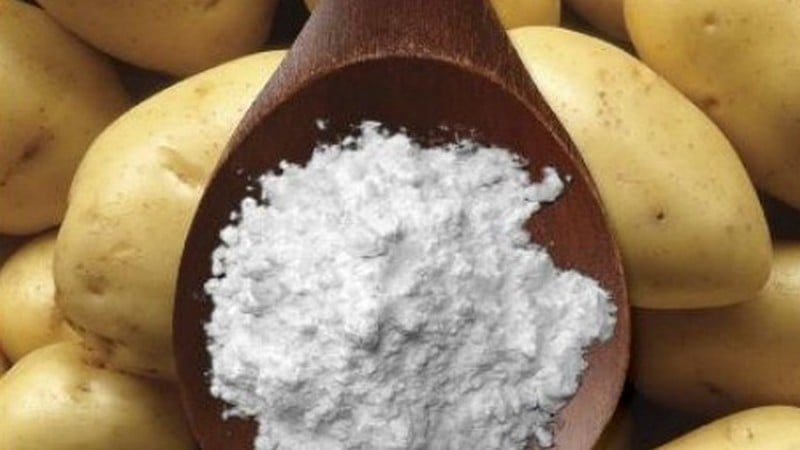What is potato starch used for and what can be made from it
Potato starch is a carbohydrate formed in the tuber as a result of photosynthesis. Under the influence of sunlight, a chemical process is triggered in the leaves of the plant, the purpose of which is to create a supply of nutrients for the roots, fruits and stems. The result is the accumulation of a substance with a polymer formula in potato tubers, which is called starch in industry and in everyday life and is used for a variety of purposes - from culinary to medicinal.
The content of the article
How starch is obtained
Synthesis of starch in potatoes - a completely natural process that does not require human participation. The task of the industry is to extract it from tubers, where the compound accumulates in the form of grains in the pulp near the peel and eyes.
The product is crushed, washed with water to obtain starch milk, and from it, using a centrifuge, a fine white powder is obtained, which is sometimes not quite correctly called potato flour.
The substance is divided into grades based on the appearance, degree of purification and acidity of the final product.... Extra and premium potato starch is white with a crystalline sheen, and the first and second - white with a grayish tint.
There are also product brands A and B, meaning the permissible moisture content: 38-40% and 50-52%, respectively.

Composition and energy value
Starch belongs to the class of carbohydrates. These are substances that provide energy for all vital processes of plants, animals, people. The chemical formula of the substance (С6Н10О5) n indicates that its molecule is a certain number of identical particles, while their exact number is unknown.
Analyzing the chemical composition, you can see that the starch molecule is a grape sugar molecule (C6H12O6), but without one water molecule. That is, in essence, these are glucose molecules, consisting of many chains.
Potato starch contains no fats and practically no protein is found, that is, it is a pure carbohydrate with a nutritional value of about 300 kcal.
Beneficial features
Starch from potato tubers is useful for the body in its natural form (i.e. directly in potatoes) and in the form of a ready-made powder, which is directly used or added to various dishes. It has enveloping, emollient and anti-inflammatory properties.
In addition to saturating the body with energy, starch has other properties:
- reduces the risk of atherosclerosis by cleansing the blood and liver from excess cholesterol;
- replenishes the lack of potassium, magnesium, sodium, and other nutrients;
- promotes the normalization of metabolism by participating in the synthesis of riboflavin and preventing its breakdown;
- helps the body in the fight against pathogenic cells, tumor and inflammatory processes (especially starch in its natural form);
- supports and strengthens the immune system;
- reduces the rate of absorption of sugar in the intestine;
- reduces acidity in the stomach and intestines, preventing the development of ulcers;
- removes excess fluid from the body, making it easier for the kidneys.
Refined starch is used in traditional medicine: application remedies for poisoning, preparation of face masks, treatment of burns.
Starch harm
Like any other carbohydrate food, too much starch can harm the body. The first and most obvious consequence of abuse is fat accumulation. The body does not have time to expend energy obtained from food rich in starch, and begins to deposit it under the skin and in the abdominal cavity.
An excess of carbohydrates can cause gastrointestinal diseases, a decrease in immunity, and sometimes even disorders of vision, speech, breathing. There are cases of individual starch intolerance.
Home cooking

For the manufacture of starch, potatoes of the most starchy varieties are selected in production. But at home, you can make it from discarded potatoes - small, damaged or slightly spoiled.
Procedure:
- Rinse the selected tubers thoroughly and grate, occasionally pouring water over it. Alternatively, grind the potatoes in a juicer, then mix the resulting mass with water 1: 1.
- Filter the mass through gauze, nylon or other fine-mesh fabric, if impurities remain, repeat the procedure.
- Let the starch milk obtained after filtration stand.
- When the starch settles to the bottom, carefully drain the liquid.
- Spread the sediment on a flat surface: parchment, cardboard, etc., layer thickness - up to 1 cm.
- Dry with a dryer, oven or any other convenient way.
The readiness of the product is determined by touch - by the absence of wet lumps. For friability, the starch is rolled out with a rolling pin. Starch is stored in closed jars, used for baking, jelly and other dishes.
Important! The drying temperature should not exceed 40 ° С, because raw starch can turn into a paste when heated.
What can be made from potato starch
Aside from the obvious culinary uses for starch, there are other uses in the home, from medicinal recipes to household needs.
Wallpaper glue
A starch-based paste has been used for pasting paper wallpaper for more than half a century. Its advantage is that even on thin and light paper there are no yellow marks and streaks, and subsequently such wallpaper can be easily removed. The same properties are also important when gluing wooden windows: the paper strips are easy to remove and leave no marks when you need to open the frames.
To prepare the glue, sift the starch, pour it with warm water and stir until smooth, and then pour in boiling water. The ratio of powder and water is selected based on the desired thickness of the glue.
The second option is to boil the water and pour in the starch in a thin stream, stirring constantly, until the required density.
Council. Such glue can be prepared for children for creative activities: it does not cause allergies and is not harmful to the body if accidentally ingested into the mouth or on other mucous membranes.
Face masks

In home cosmetology, starch has established itself as a whitening and regenerating agent.
As part of masks this connection:
- improves skin tone and elasticity;
- stimulates the process of cell regeneration and collagen production;
- brightens the skin tone in general, as well as freckles and age spots;
- increases the effectiveness of peeling formulations by acting as a catalyst for processes.
The powder is used for self-preparation masks prescription or added to facial creams. The simplest recipe for evaluating its properties is to cook "jelly" from starch and water in a 1: 1 ratio and apply with a cotton pad on the face and neck for 30-40 minutes. Then wash off the mass with warm water and, if necessary, apply a nourishing cream.
Detergent
Due to its fine structure, starch works as a cleaner. For example, if you need to clean a carpet stain, just sprinkle it with powder and leave it for 10-15 minutes, and then vacuum it.
For window cleaning, the substance is added to the water: the crystals wash away dirt and grease, leaving no streaks on the glass.
A solution of starch in water is also used for cleaning silver jewelry and cutlery: a couple of tablespoons of the powder are added to the water and the silver is soaked. After that, wash in the usual way.
Deodorant
Many people have heard about the dangers of regular use of antiperspirants, which block pores and disrupt the natural functioning of the sweat glands. Among the many alternative methods is the use of starch. Its property of absorbing moisture and odors is due to its powdery texture.
To protect against odors, potato powder is used as a dusting powder or a natural deodorant is prepared: half a glass of starch is mixed with the same amount of soda and coconut oil.
After stirring, a thick paste is obtained, which is placed in a container from a conventional stick deodorant and put into the refrigerator, where it thickens. After that, use the product on a hot day as a usual deodorant.
Remedy for burns and insect bites

Traditional medicine uses starch's ability to reduce inflammation... In case of burns, it is recommended to immediately moisten the potato starch with water and apply the mixture to the burned area: this will prevent the appearance of blisters. If there is no powder at hand, you can attach a slice of raw potatoes to the burn site.
The method also works for insect bites - starch moistened with water or a circle of raw potatoes will relieve itching and burning, and soothe the skin.
Planting carrots
Gardeners use potato powder to make the process easier planting carrots, requiring increased attention due to the small size of the seeds.
Before planting germinated seeds, they are stirred in "jelly", which is prepared according to this recipe:
- 30 g of starch is diluted in 0.5 cups of water;
- boil 900 ml of water, pour the mixture into it in a thin stream;
- put the pan in a large container with heated water and, stirring constantly, heat it up without bringing it to a boil.
Sprouted seeds are carefully poured into the cooled "jelly", and then they are planted in the ground in a "liquid way" - evenly pouring into the holes. This promotes simultaneous germination.
Modeling dough
What else is potato starch for? Some of the more interesting options include making homemade clay. It compares favorably with the store not only in its pleasant texture, but also in the harmlessness of its components. This is true for young children who are sure to taste everything that falls into their hands.
To prepare clay for modeling, mix half a cup of starch with a glass of soda in a saucepan, pour about 2/3 cup of water and add food coloring. Cook over medium heat until a thick, sticky mass forms, then remove from heat and allow to cool.
The finished mass is kneaded with the addition of a small amount (1-1.5 tsp) of vegetable oil so that the clay does not stick to your hands. At this stage, add starch if the mass is too soft. However, if you add too much powder, the clay will start to crumble.
Several portions of such a mass with different dyes will replace a whole set of plasticine, and most importantly, they will be completely safe for the child's health.
Conclusion
Potato starch is an irreplaceable substance in everyday life, if you know all the ways of its use. Even if someone cannot use it in cooking due to intolerance, the use of this substance in everyday life is available for the preparation of cosmetics, detergents and medicinal products.